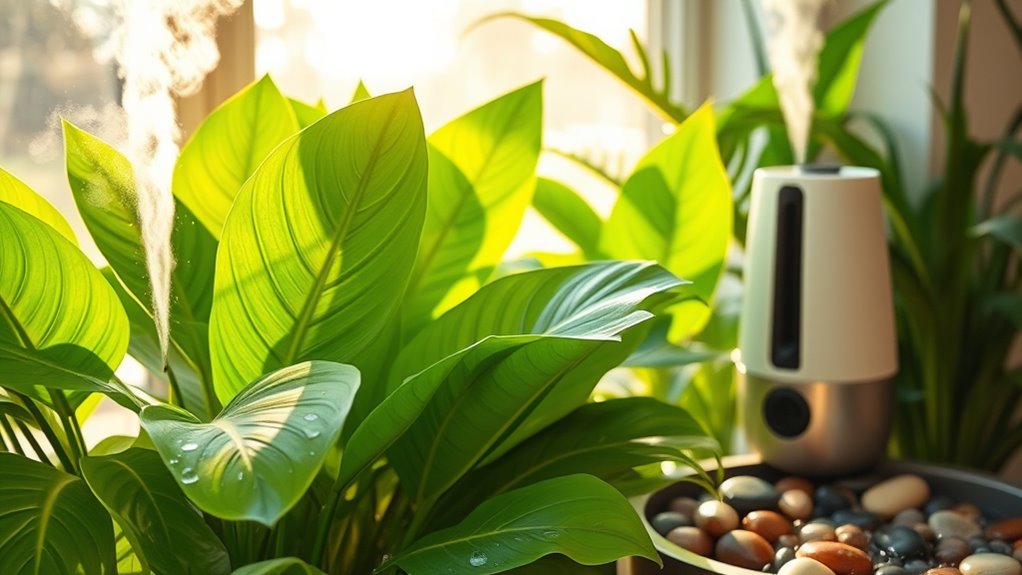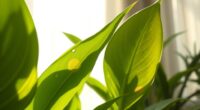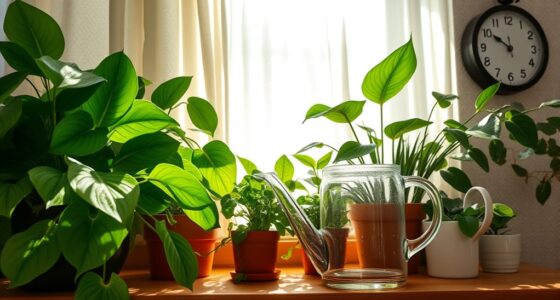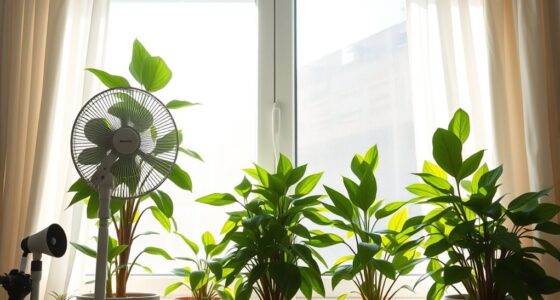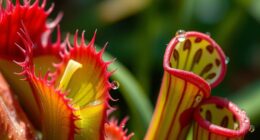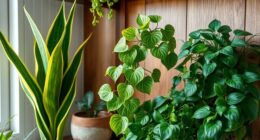To maximize humidity for your tropical indoor plants during dry summers, mist their leaves several times a day with room-temperature water and set up a regular spray schedule. Use a humidifier for consistent moisture and place plants on trays filled with water and pebbles. Avoid overwatering and guarantee proper drainage to prevent root rot. By following these tips, you’ll create a lush, healthy environment—discover more ways to keep your plants happy and thriving.
Key Takeaways
- Use regular misting with a fine spray to increase moisture around the plants multiple times daily.
- Place plants on humidity trays with pebbles and water to create a humid microenvironment.
- Incorporate a humidifier in the room for consistent, controllable humidity levels.
- Group tropical plants together to create a natural, shared humid environment.
- Ensure proper watering practices and well-draining soil to prevent stress and support healthy moisture absorption.
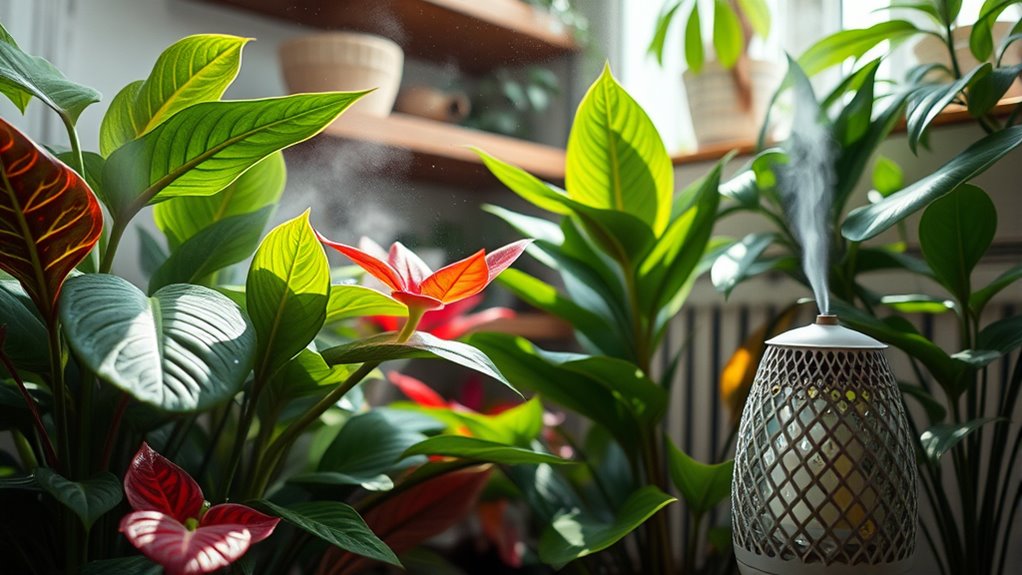
Ever wondered how to keep your tropical indoor plants thriving? During dry summer months, maintaining the right humidity levels becomes essential to prevent your plants from wilting or showing signs of stress. One of the most effective ways to do this is by paying close attention to your watering frequency and incorporating misting techniques into your routine. Both strategies help boost humidity around your plants, creating a more favorable environment that mimics their natural tropical habitat.
Boost humidity and keep your tropical plants healthy with proper watering and misting techniques during dry months.
When it comes to watering frequency, you want to strike a balance. Overwatering can lead to root rot, while underwatering causes your plants to dry out and become more susceptible to pests and diseases. During dry seasons, check your plants regularly by feeling the top inch of soil. If it feels dry, it’s time to water, but avoid giving them too much at once. Instead, water thoroughly until excess drains from the bottom, ensuring even moisture distribution. This approach keeps the roots hydrated without sitting in water, which can be detrimental. Consistency is key, as fluctuating moisture levels can stress your plants and hinder their growth.
Misting techniques are another crucial tool in your humidity-boosting arsenal. Lightly misting the leaves of your tropical plants several times a day can considerably increase local humidity. Use a spray bottle with clean, room-temperature water, and aim for a fine, even mist. Avoid overdoing it, as excessive moisture on leaves can encourage mold or fungal issues. Misting not only raises humidity but also helps wash away dust from leaves, enabling better photosynthesis. For more consistent results, consider setting up a regular misting schedule or investing in a humidifier, which can deliver constant moisture in the air without the need for manual effort. Additionally, proper light conditions can influence how well your plants absorb moisture, further supporting their health during dry periods.
Integrating these practices into your plant care routine can make a noticeable difference, especially during dry summer days. Keep an eye on your plants’ responses—wilting or browning edges may signal the need for more humidity or adjusted watering. By paying attention to watering frequency and employing effective misting techniques, you create a more humid environment that keeps your tropical indoor plants healthy, lush, and vibrant throughout the season. These small but impactful adjustments ensure your plants not only survive the dry summers but thrive in their lush, tropical beauty.
Frequently Asked Questions
Which Tropical Plants Are Most Sensitive to Low Humidity?
Some tropical plants are more sensitive to low humidity, making them less resilient in dry conditions. Humidity sensitive plants like ferns, Calatheas, and prayer plants struggle when the air is too dry. You’ll notice their leaves brown or curl more easily. To protect their tropical plant resilience, you should increase humidity around these plants with misting, trays, or humidifiers, ensuring they stay healthy and vibrant despite dry summer air.
Can Humidifiers Harm Indoor Plants?
Think of a humidifier like a gentle rain for your plants—when used correctly, it’s safe and beneficial. Humidifier safety depends on maintaining proper moisture levels, so you don’t drown your plants or encourage mold. Knowing your plant’s humidity tolerance is key. If you keep the humidity balanced and avoid over-saturating the air, a humidifier can boost your indoor plants’ health without harm.
How Often Should I Mist My Tropical Plants?
You should mist your tropical plants 1-2 times daily, depending on your indoor humidity levels. A consistent misting schedule helps increase humidity, mimicking their natural environment. Keep an eye on your plants for signs of dryness or excess moisture, and adjust your watering frequency accordingly. Remember, misting isn’t a substitute for proper watering but a way to boost humidity, especially during dry summers.
Are There Natural Ways to Increase Humidity Without Devices?
Ever wish you could turn your home into a lush rainforest? Natural methods for humidity enhancement include grouping plants together, which creates a microclimate, and placing a tray of water beneath them to evaporate moisture. You can also increase humidity by regularly misting or using pebble trays. These simple, natural ways boost moisture levels without devices, helping your tropical plants thrive during dry periods.
What Signs Indicate My Plants Need More Humidity?
You’ll notice your plants need more humidity if their leaves start to curl or develop brown tips. Leaf curl often indicates dryness, while brown tips signal that the plant isn’t getting enough moisture in the air. Keep an eye out for these signs, and you can take steps to increase humidity, like misting or grouping plants together, to keep them healthy and thriving.
Conclusion
As you nurture your tropical indoor plants, imagine a lush, misty rainforest right inside your home. Keep the air gently moist, like a invigorating morning dew clinging to leaves. By maintaining higher humidity, you’ll create a vibrant oasis where your plants thrive, their glossy leaves shimmering in the soft, humid glow. With each mist and humidity boost, you transform your space into a verdant paradise, ensuring your tropical friends flourish even during dry summer days.

